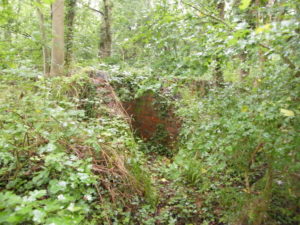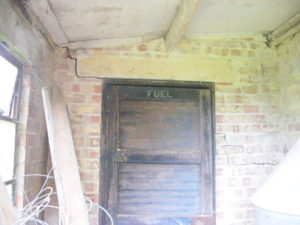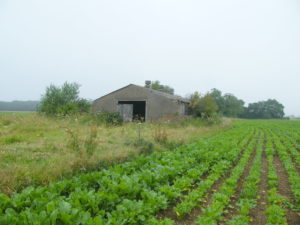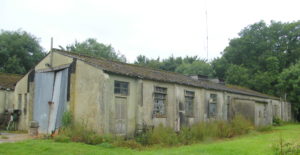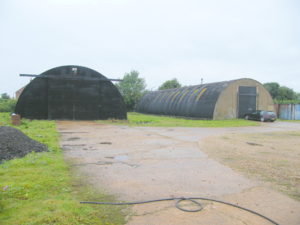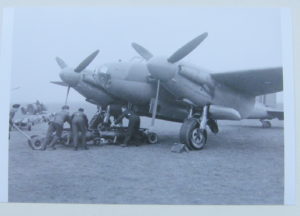RAF Downham Market has long been abandoned . The runways overgrown and the buildings mostly derelict with a few saved and adapted to small industrial units . The farmland has been reclaimed and the whole airfield has returned to private ownership .
The most recent over winter searches , with the farmer`s permission , ( Dec 2014-March 2015) have been on the field adjacent to the airfield where Lancaster D -Dog crashed in 1944. One day we hope to have a plaque placed somewhere near where D-Dog crashed . The most recent finds were uncovered in the dormitory area of the airfield in June 2016 . They are a razor, a tiny handmade lighter from a spent bullet case and a well used Macleans toothpaste tube . These can be seen in the photograph of Flt Lt Colin Bell DFC.
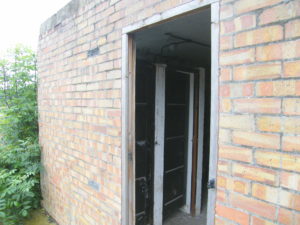
Whilst the airfield was active there would have been about 2,000 people living and working on the site . The town would have been busy with an almost doubling of the population ; the skies would have been full of aeroplanes coming and going , the roads full of traffic . Some of the service men and women would have lodged in the town with families and that would have conferred an intimacy with the work and dangers of the airfield . Accidents did happen and although the town itself was not damaged , there were some close run accidents .
Ops book : 27th October 1942 . 15 Squadron.
16 Aircraft detailed to garden at Deudar . One brought bombs back , rear turret unserviceable , others planted . One landed at Downham Market . AIR 27/203 .
28th Oct 1942 . 14.07 Mr Tyson to test Stirling B No N 3720 ; 14.25 aircraft now at Sebros . 15.30 Downham Market contacted us through GR as to weather , have reported that weather was unfit .
Ops book : RAF Bourn ROC reported have reported that a Sterling has crashed 5 miles SW of Downham Market The crash was not a Stirling but may possibly be a 2 engine fighter . 29th October 1942 .
Aircraft crashed at Downham Market is Q15 time 11.50 . 5 bodies recovered unrecognisable . Aircraft disappeared completely . AIR 14/2539 .
The pilot took off at 11.08 to test the aircraft following a rigging check . This had been made on account of a complaint by a previous pilot that the rear fuselage shuddered doing a rate 2 turn and when pulling out of a dive.
About half an hour after take off the aircraft was seen flying slowly below the cloud which was 1200 ft . It then went into a steep dive which continued to the ground .
All the occupants were killed instantly , the aircraft crashed near the Old Bedford River forming a large crater in the fenland mud . Owing to the proximity of the river bank , it was impossible to effect salvage and the crater was filled in . AVIA 5/21 AIB . 29 /10/1942 .
Avro Lancaster 111 : F2 , D-Dog ND 841.
Pilot : F/O George Ambrose Young. 635 Sqdn aged 24 buried Southampton.
Flight Engineer: Sgt Thomas Snowball. 635 Sqdn aged 32 buried Tynemouth.
Navigator: F/Sgt Howard Pritchard .635 Sqdn aged 22 buried Tettenhall Regis.
Bomb Aimer: F/O Walter Thomas Olyott. 635 Sqdn aged 21 (buried St Edmunds churchyard).
Wireless operator : Robert Sadler .635 Sqdn aged 23 (buried St Edmunds churchyard).
Air Gunner : F/Sgt Stanley Wharton. 635 Sqdn aged 30 (buried St Edmunds churchyard).
Air Gunner ; F/Sgt Charles Patrick Nallen . 635 Sqdn aged 20 ( from Australia) buried Cambridge City cemetery.
D-Dog took its place on the main runway , and attempted to take off at 00.27 hours 4th June 1944. Because of the variable weather, D Day had been postponed from 5th June to 6th June. Therefore D-Dog was going to bomb any German batteries on the coast of France . It swung to starboard from the main E – W runway , clipped the top of a B1 hangar , and crashed just outside the airfield boundary, near to Broomhill farm. All the aircrew were tragically killed instantly. The target for this operation was the coastal batteries around Calais in France . The remaining 8 aircraft dropped their bombs and returned safely .
The official Operations Record Book for 635 Squadron , RAF Downham Market ( National Archives ) for 1st to 10th June 1944 is as follows . ” 1.6.44. Stood down.
2.6.44. Stood down. Lecture on Master Bomber and Deputy Master Bomber . Decorations awarded to S/L Roache DFC and F/S Wrigley , DFM . Missing Personnel decorations awarded included F/L Nicholls , DFC, P/O Easson, DFC , W/O Jolly , DFM .
3.6.44. 9 Aircraft detailed to attack Calais . “S” P/O Bourrassa , “C” F/L Johnston , ” B ” P/O Hayes , “E” F/L Connolly , “J” P/O Johnson “A” P/O Vines , “D” F/O Young P/O Johnson ( Aus) “E” S/L Roache .
“D” F/O Young hit hangar after taking off and crashed on airfield when large bomb exploded and the crew all killed . 8 aircraft returned to base .
6 aircraft of B flight on night flying exercises “X” W/C Voyce “P” F/L Wheble , “M” S/L Bazalgette , “T” F/L Henson “W” F/S Griffiths , “N” F/O Swan .
4.6.44. Stand down. Defence talk to all Defence Flight Commanders by the Station Commander .
5.6.44. 9 aircraft detailed to attack Longues ( Caen) and 2nd front opened . “R” F/S Griffiths , “D” P/O Healey , “Y” F/L Henson , “H” F/L Connolly , “J ” P/O Johnson , “K” F/L Johnston , “B” S/L Henderson , “M” S/L Bazalgette , “N” F/O Swan . 6 aircraft detailed to attack Ouithrehain ( Caen) “A” P/O Vines , “W” P/O Weaver failed to get off . “C” P/O Beveridge , “G” P/O Bourrassa , “P” F/L Wheble , “S” W/C Voyce , “X” F/L Gillmore , all aircraft returned to base . S/L Roache and P/O Beveridge on practice Master and DMB flying .
6.6.44. 14 aircraft detailed but all cancelled with the exception of “Y” F/L Smith “X” F/L Gillmore , master and deputy master bomber . Aircraft attacked Lisieux Choke point. Returned to base .
Copyright of the above from the National Archive AIR 27 /2155.
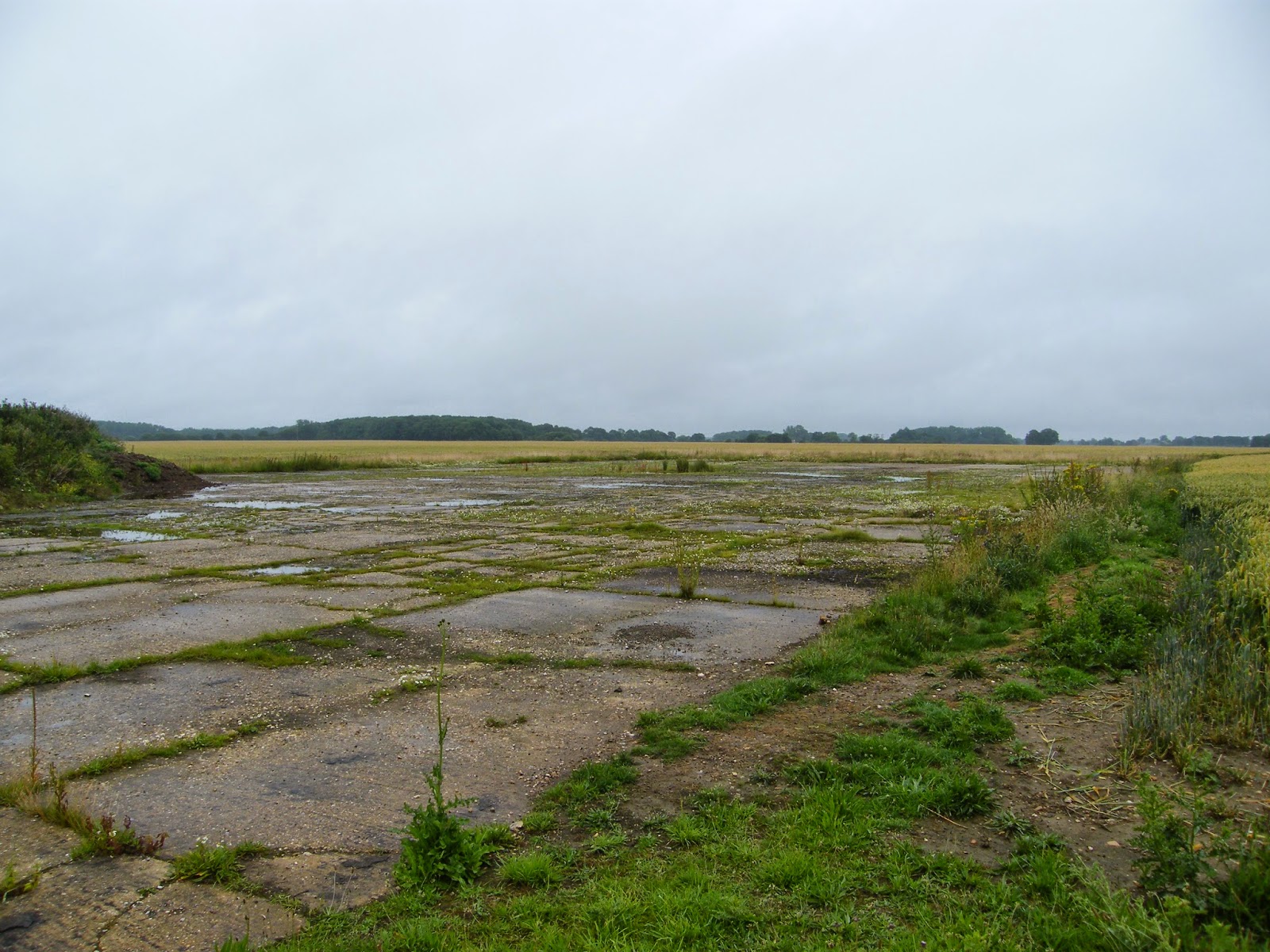
RAF Downham Market was built as a result of the expansion plans which were adopted after WW2 started . The site was fairly flat and well drained and was higher than the surrounding fenland . Construction began in late 1941 ; the main contractor was W & C French Ltd. The sand and gravel pits at Tottenhill were opened to provide the raw materials for this huge undertaking . Hundreds of Irish labourers were employed to construct the airfield . There were 3 runways which were all 50 yards wide . These were laid out in a triangular pattern , east – west , N/W – S/E , N/E – S/W . The main runway ran approximately East – West and was 2,000 yards long .
Most buildings were of single brick thickness with a 3 inch concrete render on the outside , with asbestos sheet roofs . Many other buildings were of the semi circular , corrugated iron , Nissen hut type. The three runways were linked by three miles of perimeter track with thirty five circular aircraft dispersal areas spread around . In all there were six aircraft hangars used for maintenance and storage . Miles of drainage and wiring was installed including two sewage treatment works . Bomb stores were built on the North East corner of the aerodrome . These comprised rows of bomb pits protected by brick and earth blast walls which were heavily camouflaged with netting .
The main Downham to Swaffham road bisected the aerodrome . To the north was the flying and technical side , the main entrance being where Bexwell kitchens are today . This building was once the guard room . To the south of the road were the dormitory sites , mess sites and communal sites , which included NAAFI , post office, cinema, squash courts and gym. RGD engineering on the A 10 at Stone Cross was the site of the officers mess . The whole airfield covered a huge area , in order to prevent the base being wiped out by enemy air attack . This was a base with nearly 2,000 airmen and women at its busiest . It became fully operational in June 1942.
Initially the airbase was used to land Wellington and Stirling aircraft from RAF Marham after the first thousand bomber raids . In July 1942 , 218 squadron with its Stirling aircraft arrived from Marham and they were based here until March 1944 . Marham was a WW1 airfield but as late as 1942 it still had grass runways which were obviously unsuitable for 4 engine heavy bombers like the Stirling . RAF Downham Market now came under 3 Group Bomber Command .
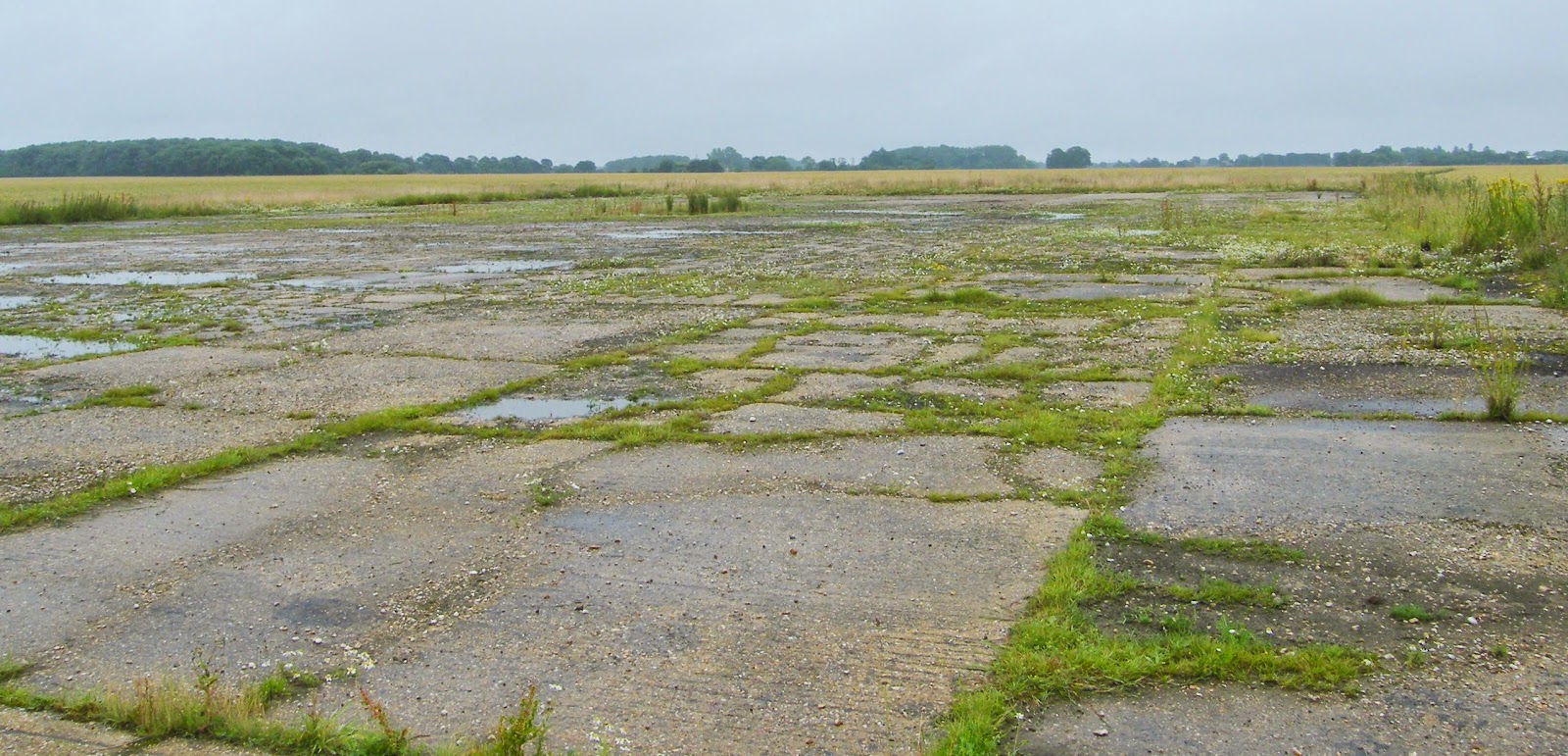
The Stirling bomber was a very robust and manoeuverable aircraft , much liked by its crewmen .Its main deficiency was that its wingspan of 99 feet meant that it suffered from lack of lift to get to high altitudes away from flak which made it an easy target for enemy anti-aircraft fire . The original design was made in the 1930s when hangar doors were 100ft wide , and the aircraft was built with this in mind . 218 was known as the Gold Coast Squadron as it had been sponsored by the Governor and people of the Gold Coast , now known as Ghana . It was the squadron of Flt Sgt Aaron who won the VC whilst serving at RAF Downham , and a memorial plaque is today sited beside the church at Bexwell commemorating him and Ian Bazalgette also awarded a VC .
Between July 1942 and March 1944 ,218 squadron flew 1,787 operational individual sorties from RAF Downham Market.. The first of these 438 were mine laying duties off the Frisian Islands on the north west coast of Germany. Of the squadron aircraft , 77 failed to return , and 20 squadron aircraft crashed in Britain . ( A very high attrition rate when you consider that each aircraft lost had a crew of 7 men .) In April 1943 Stirling bomber E-Easy while on route to bomb Stuttgart , flying low level , hit an electricity pylon and damaged the fuselage and electrical sparks ignited incendiary bombs on board. With remarkable bravery , the pilot managed to dump the bomb load and made a safe return to RAF Downham , a testimony to the toughness of the Stirling bomber.
But even when the aircraft had landed , the crew were not necessarily safe. In May 1943 , Stirling I-Item , damaged by flak over Germany , landed and swung off the runway up onto the banked side of the blast shelter and continued smashing into the building in the operations block where two aircrew from another flight were being debriefed . Both were killed in the impact .
Citation
The London Gazette of 7th November, 1943, gives the following details in the citation. On the night of 12th August, 1943, Flight-Sergeant Aaron was captain and pilot of a bomber detailed to attack Turin. When approaching its target, the aircraft was hit by fire from an enemy fighter, which caused it to become unstable and difficult to control. Flight-Sergeant Aaron was wounded in the face and lung, and his right arm was rendered useless. After a rest, he made determined efforts to take control again – persuaded to desist, he wrote instructions with his left hand, and guided the bomb-aimer in the hazardous task of landing the damaged aircraft at Bone in North Africa. Nine hours after landing, he died of exhaustion. In appalling conditions he showed the greatest qualities of courage, determination and leadership, and though wounded and dying, he set an example of devotion to duty which has seldom been equalled and never surpassed.
The following particulars are given in “The London Gazette,” of 14th August 1945. He flew in a Short Stirling bomber of 218 Gold Coast Squadron detailed to bomb Turin .
623 squadron was also equipped with Stirling bombers and they were based at RAF Downham briefly from August to December 1943 . 623 was formed from 1 flight of 218 squadron and the intention was to make it 2 flight with 20 aircraft . But it never achieved more than 10 aircraft strength before being disbanded. However during its short life , it flew 137 operational sorties , mostly bombing but some mine laying . Incredibly 10 aircraft failed to return , one crashing on the airfield itself , so out of 10 strength , all were lost and had to be replaced. Not just the aircraft but all 7 crew of each of the 10 aircraft. This was a very heavy loss rate and a constant crisis for Bomber Command to lose a whole squadron strength in four months.
214 squadron of Stirling aircraft were at RAF Downham from December 1943 to January 1944 perhaps to fill the gap left by the losses of 623 squadron . In this short period they made 36 sorties , 25 to the flying bomb sites, V1 and V2 , and 11 minelaying . They subsequently were reassigned to RAF Sculthorpe .
Bomber Command in November 1943 withdrew the Stirling from main force attacks on Germany and became the attack force against the flying bomb sites in France , mining duties and air sea rescue searches . Bomber Command reorganised its forces and RAF Downham ceased to be part of 3 Bomber Command and transferred to 8 Group the Pathfinders. The war in the air had for this small airbase cost a great many lives and aircraft . The tour of duty for aircrew was 30 missions , many did many more , fighting against the odds of one in seven aircraft not returning with the loss of all 7 crew per aircraft , though some were saved to become prisoners of war , or were injured dreadfully .
From March 1944 , RAF Downham came under 8 Group RAF Pathfinder force . Although it still remains one of the most successful advances for the RAF , it was immensely dangerous and complex. In today`s world of Satnav and GPS range finding a target seems simple but then the practice was to send out aircraft with master bombers to pinpoint a target for the following bombers . But so it was that the master bomber flew round the target to assess how successful the pathfinders had been in identifying and marking their target with flares and coloured target indicators . And to gives the thumbs up by radio to go ahead with bombing or to change the target indicators to a different position . And this brought RAF Downham to the vanguard of Bomber Command`s raids .
Pathfinder crews were by the very nature of the job extremely experienced and had usually completed at least one if not two 30 operational tours of duty . The aircrew serving with the Pathfinders usually faced a 45 operational tour of duty . After the 45 tour was finished they were given the options of 6 months rest or a further 15 ops . Most chose the latter.
635 squadron were equipped with the magnificent Lancaster bombers and arrived at RAF Downham in March 1944 and remained until the war`s end in September 1945 . It was new to Downham and made up of aircrew from B flight of 35 squadron from RAF Gravely and C flight from 97 squadron RAF Bourn. Its first operation was on 22nd March 1944 to Frankfurt . The Lancaster could carry 14,000 lbs of bombs and target indicators . It was a formidable weapon unleashed against German cities and industrial areas. It had also had the latest in target finding radar equipment which sometimes required an extra member of crew to operate and to help with navigation and bomb aiming .
“Master bomber”
On 4th August 1944 Squadron Leader Bazalgette was of a Pathfinder Squadron detailed to mark an important target for the main bomber force. When nearing the target his Lancaster was seriously damaged and set on fire by anti-aircraft fire; the bomb aimer was badly wounded. As the deputy had already been shot down, the success of the attack depended on Squadron Leader Bazalgette who despite appalling conditions in his burning aircraft pressed on gallantly, bombed, and marked the target accurately. That the attack was successful was due to his magnificent effort. The condition of the aircraft had by now become so bad that Squadron Leader Bazalgette ordered his crew to leave the aircraft by parachute. He attempted the almost hopeless task of landing the crippled and blazing aircraft to save the wounded bomb aimer, and one air-gunner, who had been overcome by fumes. With superb skill and taking great care to avoid a French village, be brought the aircraft safely down. Unfortunately it then exploded and this gallant officer and his two comrades perished. His heroic sacrifice marked the climax of a long career of operations against the enemy. He always chose the more dangerous and exacting roles. His courage and devotion to duty were beyond praise. He was flying a Lancaster , T for Tommy , as Master Bomber , of 635 squadron .
The squadron flew a total of 2,099 operational sorties and lost thirty four aircraft on operations , plus a further seven which crashed in Britain . For a squadron only in existence for 18 months , this is a very high rate of losses. But it existed during the final year of the war when the tide was turning and everything was thrown at the Axis powers to bring the war to an end. It was during such a raid on Dresden in February 1945 that such squadrons were used . Their CO Wing Co Sidney (Tubby) Baker, DSO and bar, DFC and bar, completed his 100th mission to Wuppertal in March 1945. He was 27 years old . 635 flew for the last time in April 1945 when it bombed Hitler`s mountain hideaway at Berchtesgaden . In the peacetime world 635 dropped food supplies to the Dutch people in an operation known as Manna . And were instrumental in repatriating allied prisoners of war known as operation Exodus .
Not generally known is that after the war , 635 squadron was engaged in happier duties between April and May 1945 when they took ground personnel over the bomb damaged German cities , so that they could see for themselves the results of the bombing campaign they had all worked tirelessly to achieve . These were known as “Cooks Tours” !!!
608 squadron has the distinction of being the last to bomb Kiel Harbour and maybe even of dropping the last bomb of the war , this aircraft returned to RAF Downham at 2.18 am 2/3rd May 1945. This last raid was sent over in two waves, with 8 aircraft in each wave , each carrying 4,000 lb bombs . 608 was equipped with the Mosquito bomber , part of 8 Group Pathfinders, Light Night Striking force . It was reformed at RAF Downham Market in August 1944 and was a fast though lightly armed bomber , despite being largely constructed of wood, it was highly versatile and fast , it carried a two man crew and between August 1944 and the last flight in May 1945 , the squadron flew 1,685 sorties from RAF Downham of which 11 aircraft failed to return and 7 others crashed in the UK . One in October returning clipped the tower of Stow Bardolph Hall and crashed in Wimbotsham , killing both crew members . All the raids were directed to the heartland of Germany , including 762 individual sorties over Berlin.
see also: http://www.geograph.org.uk/article/RAF-Downham-Market.
Probably the most exciting event of recent times concerning the airfield , was the visit , albeit fleeting , of Flt Lt Colin Bell , DFC , in January 2018 . He flew from Downham with 608 squadron in 1944 with his Canadian navigator Flt Lt Redmond . He is one of the very few left who flew from Downham , in fact may well be the only survivor . He flew in Mosquito XX aircraft . From the National Archives AIR/27/2101 these are some of Flt Lt Bell`s sorties over Germany . They illustrate how relentless the work was , day after day , taking off in the darkness for Germany and knowing that they faced flak , fighters etc . Its a plain report of truly heroic actions by dozens of young men . For some 700 plus of these young airmen , the last green grass they stood on was the runway at Downham .
608 Squadron and Colin Bell DFC .
Mosquito IV de Havilland , re loading RAF Marham , 105 squadron 1942.
Operations record book from the National Archives , AIR/27/2101 for October 1944.
2/10/44 39 hours .
9 Mosquito XX – 21- crews 8 a/c to attack Brunswick Flt Lt Bell , F/O Redmond . KB 360 H . All attacked primary dropping 24 x 500 MC 8 x 500 GPLD between 2035 and 2037 hours from 23,000 ft .Weather clear. Vis very good . All crews saw route markers and all bombed the centres of red and green TI s which were failry well concentrated . At 2039 hrs a large column of smoke was seen from target aread . Four fires were seen two of which were large . Moderate to accurate H/F was encountered no S/L in action.
3/10/44 . 33 hours .
9 Mosquito XX – 21 – crews 6 a/c to attack Saarbruck Flt Lt Bell , F/O Redmond . KB 261 D . One a/c failed to take off other five windowed as ordered and dropped 20 x 500 GP between 2020 and 2025 from 20/25,000 ft . Weather clear , vis good.
6/10/44 23hrs 37 mins .
6 a/c to attack Berlin . Flt Lt Bell , F/O Redmond KB 441 Q . One a/c did not take off . The other five attacked dropping 15 x 500 GP and 5 x 500 GPLD between 2020 and 2025 hours from 23/22, 000ft . Weather clear vis good TI s seen 2220 , other reds and greens later . Marking generally scattered some cookie bursts seen in area , also dummy red TI to the west of target . Moderate to intense H/F and S/L were active .
10/10 /44 32 hrs 15 mins .
11 Mosquito XX – 22 -crews . 11 a/c to attack Cologne . Flt Lt Bell , F/O Redmond . KB 235 A . Nine a/c attacked dropping 27 x 500 MC , 9 x 500 GPLD between 1943 and 1947 hrs from 20/23,500 ft . Weather 10/10 str cu above green TI seen 1941 hours and red floaters seen at 1942/43/44 hours . These disappeared in cloud . Glow suggested triangular formation over whole area 6 a/c bombed on red TI s or glow and 3 on estimated position of TI s which had disappeaed into cloud . Several cookie bursts seen and a large bluish white explosion lasting several seconds was reported by several crews at 1946 hours . A smaller explosion was seen at 1948 hours . Fires were also seen reflected on clouds . One a/c crashed on t/o crew unhurt . One a/c brought bombs back , hang up . Mod predicted H/F . No S/Ls .
13/10/44 32hrs 26 mins .
13 Mosquito XX -22-crews 12 a/c to attack Koln . Flt Lt Bell ; F/O Redmond . KB 417 D.
14/10/44 13 Mosquito XX – 24 – crews 8hrs 13 min. 2 a/c to attack Mannheim Flt Lt Bell , F./O Redmond , KB 235 A . Both a/c attacked dropping 2 x 250 TI green and 6 x 500 MC at 0159 – 0202 hours from 23/24,500 ft Weather 5/10 str cu tops 5/10,000 vis fair . Red T I s seen at 0156, 0159 , 2020 , 0210 hours . Green T I s seen at 0159 hrs . T I s well concentrated . No bombing results observed . A spoof red T I seen 30 miles west of target at 0204 hrs slight to moderate H/F and about 40 S/Ls attempting to cone .
16/10/44 . 12 Mosquito XX 27 crews , 2240 hours , 11 a/c to attack Cologne Flt Lt Bell , F/O Redmond KB 417 D . All a/c attacked primary dropping 33 x 500 MCTD and 11 x 500 GPLD between 2328 and 0015 hours . Weather 10/10 , cirrus very hazy . Most aircraft bombed on Gee and DR some report of glow of red T I s and confirmed their positions. Cookie bursts were seen in area. No crew saw route markers . There was slight pockets of H/F , No fighter activity .
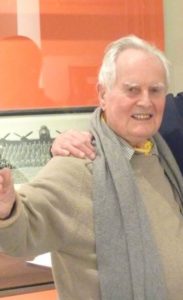 Flt Lt Colin Bell DFC at Downham , January 2018.
Flt Lt Colin Bell DFC at Downham , January 2018.
23/10/44. 10 Mosquito to attack Berlin. Flt Lt Bell, F/O Redmond , KB 417 D . 9/10 Mosquito attacked primary dropping 30 x 500 GP and 10 x 500 GPLD between 1930 and 1936 hrs from 23/25,5000 ft . Weather 10/10 cirr/cu tops 12/15, 000 ft , vis good . First red T I seen to cascade at 1927 hrs followed by further reds at 1928 and 1930 hrs all of which formed a good concentrated and enabled all crews to bomb accurately . Cookie bursts seen under to concentration of T I s . There was slight H/F no S/Ls . I a/c detailed to attack Berlin experience trouble with port engine . In addition to which Gee , Loren and VHF were u/s so bombed unidentified target in Germany pos 54.15N O855E at 18.55 hrs 25,000 ft .Weather as for primary . Slight H/F was encountered.
27/10/44 . 17 Mosquito XX – 21 crews- to attack Berlin . Flt Lt Bell, Flt Lt Redmond 235 A . 12/12 a/c attacked primary dropping 32 x 500 GP and 10 x 500 GPLD between 2303 and 2310 hrs from 20/23, 800 ft . Weather 10/10 , cirrus ?
29/10/44 . 15 Mosquito XX – 22 crews- 12 Mosquito to attack Cologne Flt Lt Bell, Flt Lt Redmond . KB 406 K . All a/c attacked primary dropping 36 x 500 GP and 11 x 500 GPLD between 1957 and 2000 hours from 22/25,750 ft . Weather clear vis good . A cloudless sky enabled all a/c to bomb red T I s which were clearly seen over target Markers made a very good concentration and bombing was accurate . Many fires from the attack of the previous night seen over a very large area of target .
31/10/44 . 10 Mosquitos to attack Hamburg . AB 405 K Flt Lt Bell , Flt Lt Redmond. All a/c attacked primary dropping 30 x 500 GP and 10 x 500 GPLD between 2127 and 2134 hours from 22/25, 000 ft . Weather 10/10. Str cu , vis good .
There are memories of the men and women who served in the short but urgent years of the war . The church and the Crown in the town have black and white photos of the airmen and their crews . And for some young men , nearly 750 , the town and the airfield were the last of home . Amazingly this airfield lost that number of crew and today we have almost forgotten who they were . A memorial has been designed and planned , it will carry the names of all those who were lost . At the moment all we have is the small memorial to the two VC s Bazalgette and Aaron , but in time and with funding , we hope to have a substantial memorial.
It is good to note in April 2018 that the International Bomber Command Memorial has opened with all the names of those who were lost including our 770 from RAF Downham in Lincoln .
rafdownhammarket.com see also .
